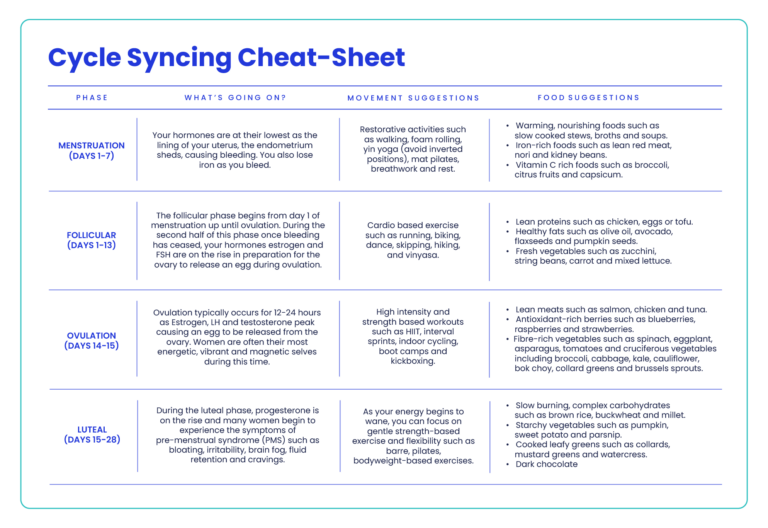BLOG:
How to Optimize Your Nutrition and Training for Your Menstrual Cycle
This is a guest article on Cycle Syncing written by Sarina Coventry, Clinical Nutritionist and EFT Practitioner

Cycle syncing is a practice that involves altering your diet and exercise routine around different phases of your menstrual cycle to support your hormones and optimize how you feel.
As women, we’re constantly in a dynamic state of change with fluctuating hormones day by day, and throughout our menstrual cycle, that change the way we feel. Our energy is affected, our moods change, our body changes, even our strength and flexibility change. Cycle syncing is a fantastic way to help support your body through these changes.
Although the concept of cycle syncing may seem new and unusual, it offers an incredible tool to provide education surrounding the menstrual cycle and how you can begin to work WITH your body rather than AGAINST it.
What is the Cycle Syncing Method?
The term ‘cycle syncing’ was coined by Functional Nutritionist, HHC, AADP Alisa Vitti. It involves a practice in which your nutrition, movement and lifestyle are structured in accordance with the four phases of your menstrual cycle: the menstrual, follicular, ovulation and luteal phases. This cycle is typically 28 days; however, a normal cycle can range between 21-35 days.
Additionally, there are five main hormones that fluctuate across these four phases: follicular stimulating hormone (FSH), luteinizing hormone (LH), estrogen, progesterone, and testosterone.
These hormonal transitions influence your brain chemistry, immune system, metabolism, microbiome (bacteria present in the gut) and stress response. Ultimately, changing the way you respond and react to the world around you. Who would’ve thought?!
As a clinical nutritionist with a Bachelor of Health Science, I regularly witness the importance of diet and nutrition in supporting a healthy reproductive system and menstrual cycle. I have also seen AND personally experienced the game changing effects of aligning your movement with this cycle too.
By adjusting your lifestyle to support the phase-specific needs of your cycle, you can begin to reduce the nasty symptoms of PMS, restore fertility, regain energy, creativity and so much more!
How do I start cycle syncing?
The hormonal shifts experienced across each phase of the cycle have a downstream effect on a woman’s nutritional needs. By incorporating phase-specific foods and movement, you can begin working with your body rather than against it. Just simply by becoming more in tune with the shifting phases of your cycle, you’re already halfway there!
Here is a breakdown of each menstrual phase, and how you can align your nutrition and exercise with each phase:
Menstruation (Days 1-7)
The first day of menstruation (bleeding) marks day 1 of your cycle and this phase can last between 3-7 days. Your hormones are at their lowest as the lining of your uterus – the endometrium – sheds, causing bleeding.
Nutrition
During this phase it’s important to incorporate warming, nourishing foods such as slow cooked stews, broths and soups. It’s time to pull out that slow cooker!
As you bleed, you also lose iron, so incorporating lean red meat, nori and kidney beans can help to remineralise your body. Be sure to pair it with vitamin C rich foods such as broccoli, citrus fruits and capsicum to enhance its absorption.
Movement
Restorative activities such as walking, foam rolling, yin yoga (avoid inverted positions), mat pilates, breathwork and, of course, napping!

Follicular Phase (Days 1-13)
The follicular phase begins from day 1 of menstruation up until ovulation. During the second half of this phase, once bleeding has ceased, your hormones estrogen and FSH are on the rise in preparation for the ovary to release an egg during ovulation.
Nutrition
During the follicular phase it’s normal to have a smaller appetite. Focus on lean proteins such as chicken, eggs or tofu whilst incorporating healthy fats such as olive oil, avocado, flaxseeds and pumpkin seeds to support hormone production.
Don’t forget to fill your plate with fresh vegetables such as zucchini, string beans, carrot and mixed lettuce. Try to keep these vegetables in their raw form or opt for lighter cooking methods such as steaming or sauteing.
Movement
Cardio based exercise such as running, biking, dance, skipping, hiking, vinyasa and HIIT.
Ovulation (Days 14-15)
Ovulation typically occurs for 12-24 hours as estrogen, LH and testosterone peak causing an egg to be released from the ovary. Women are often their most energetic, vibrant and magnetic selves during this time.
Nutrition
Similarly to the follicular phase, your appetite may be low. Aim to include lean meats such as salmon, chicken and tuna, whilst also including berries rich in antioxidants such as raspberries and strawberries.
To optimize the detoxification of estrogen from your liver, focus on fibre-rich vegetables such as spinach, eggplant, asparagus, tomatoes and cruciferous vegetables including broccoli, cabbage, kale, cauliflower, bok choy, collard greens and brussels sprouts.
Salads and smoothies are ideal during this time!
Movement
High intensity and strength based workouts such as HIIT, interval sprints, indoor cycling, boot camps and kickboxing.
Luteal Phase (Days 15-28)
During the luteal phase, progesterone is on the rise and many women begin to experience the symptoms of pre-menstrual syndrome (PMS) such as bloating, irritability, brain fog, fluid retention and cravings.
Nutrition
During the luteal phase, our need for calories increases and so too does our requirements for blood sugar-stabilizing foods. Ensure you’re eating at regular eating times (every 3-4 hours) or at the first indication of hunger.
To reduce the incidence of PMS related symptoms, it’s important to include slow burning, complex carbohydrates such as brown rice, buckwheat and millet as well as starchy vegetables such as pumpkin, sweet potato and parsnip, ideally roasted or baked.
Foods rich in B vitamins, magnesium, calcium and fibre will also mitigate these symptoms whilst supporting the lead up to menstruation. This may include cooked leafy greens such as collards, mustard greens and watercress with a cheeky piece of dark chocolate to curb cravings.
Progesterone may slow down your digestive system, causing constipation. Ensure you’re sipping on plenty of fluids such as water and herbal teas, aiming for 2-3L/day.
If the egg hasn’t been fertilised during this cycle, the end of the luteal phase is signified by a rapid drop in our hormones, causing a shedding of the uterine lining and beginning of the menstrual phase.
Movement
As your energy begins to wane, you can focus on gentle strength-based exercise and flexibility such as barre, pilates, bodyweight-based exercises.

By tailoring your diet and physical activity to each menstural phase, you can experience a range of benefits, from reducing PMS symptoms to enhancing energy and creativity.
If you’d like to start incorporating some cycle syncing practises, save the cheat sheet above to see food and exercise suggestions at each stage of your cycle! You can also save the pdf version here.





